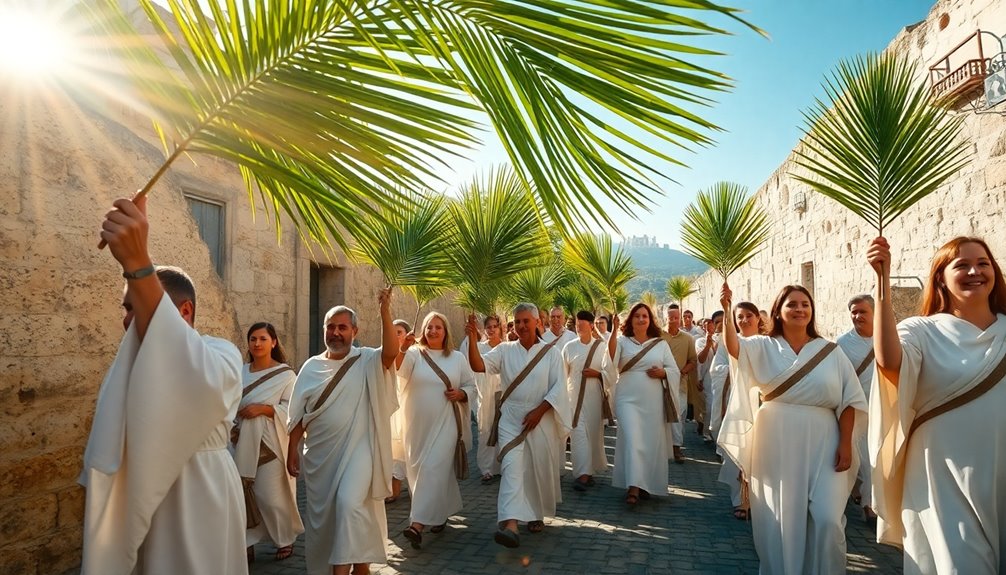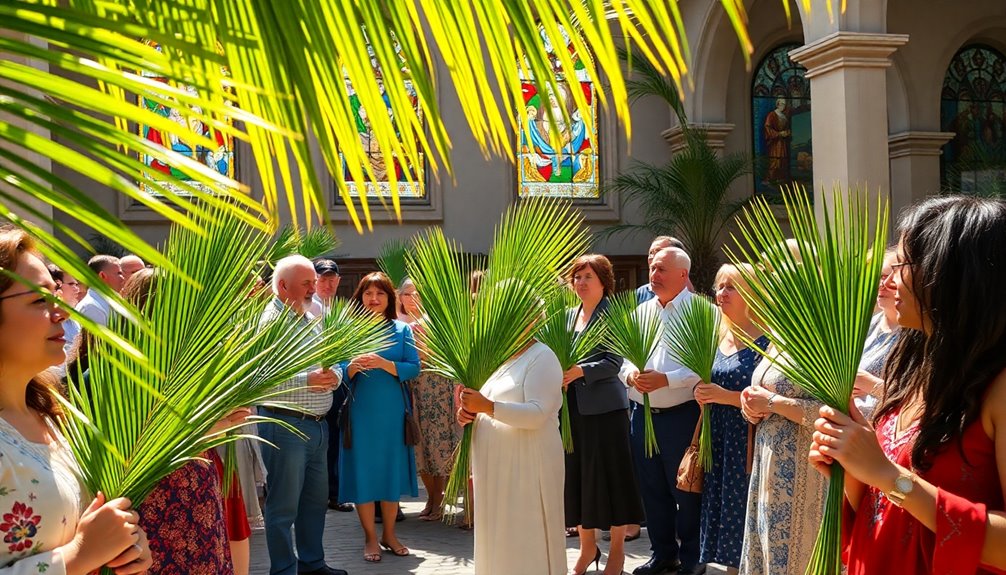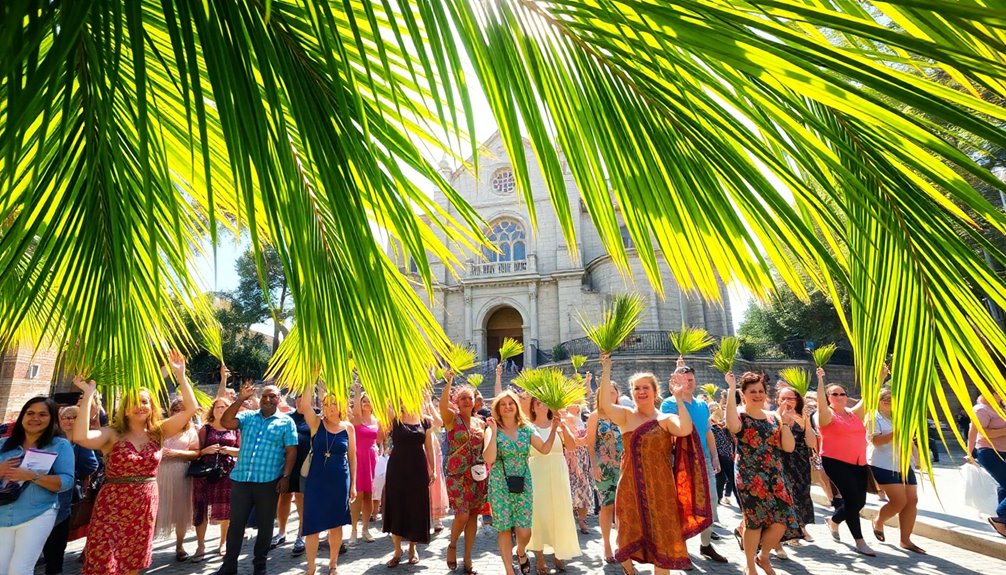Palm Sunday marks the beginning of Holy Week, commemorating Jesus' triumphal entry into Jerusalem. As you observe this day, you'll notice crowds welcoming Him with palm branches, symbols of victory and peace. This event fulfills Old Testament prophecy, highlighting the humility of Jesus riding on a donkey. While many celebrate it as a festive occasion, it invites deeper reflection on the contrast between joy and the impending sacrifice of Holy Week. Engaging with this deeper meaning can enrich your understanding of faith and its implications. Explore how this day influences your spiritual journey for a more profound experience.
Key Takeaways
- Palm Sunday commemorates Jesus' triumphal entry into Jerusalem, marking the beginning of Holy Week and fulfilling biblical prophecy from Zechariah 9:9.
- Crowds greeted Jesus with palm branches, symbolizing victory, peace, and recognition of Him as the Messiah, reflecting their plea for salvation.
- The donkey Jesus rode symbolizes humility and peace, contrasting with expectations of a warrior king, reinforcing His identity as the true Messiah.
- Palm Sunday encourages reflection on faith and the duality of celebration and impending suffering, inviting believers to embrace humility and service.
- Celebrations include rituals like singing hymns and community outreach, emphasizing acts of kindness in the spirit of Jesus' compassion during His entry.
Introduction

Palm Sunday marks a significant moment in the Christian calendar, celebrated on the Sunday before Easter. This day commemorates Jesus' triumphal entry into Jerusalem, a powerful event that sets the stage for the events of Holy Week.
As you reflect on this occasion, think about the crowds that greeted Jesus with palm branches and their enthusiastic shouts of "Hosanna." This joyful reception highlights the people's recognition of Him as the Messiah, fulfilling the prophecies laid out in the Old Testament.
In Zechariah 9:9, the arrival of a humble king riding on a donkey is foretold, and that's exactly how Jesus entered the city. The use of palm branches symbolizes victory and peace, emphasizing the hope the people felt as they welcomed their king.
Palm Sunday isn't just a celebration; it's a precursor to the Passion narrative, leading you to contemplate the events that follow, including Jesus' crucifixion and resurrection.
As you participate in this important day, consider its profound meaning in the context of your faith and the larger Christian story.
Biblical Basis for Palm Sunday

When you look at the biblical basis for Palm Sunday, you'll find it firmly rooted in the Gospel accounts of Jesus' entry into Jerusalem.
Each Gospel—Matthew, Mark, Luke, and John—provides a unique perspective that highlights the significance of this moment.
Primary Bible References
The biblical basis for Palm Sunday is firmly rooted in the accounts found in all four Gospels. In Matthew 21:1-11, Mark 11:1-11, Luke 19:28-44, and John 12:12-19, you find the detailed narrative of Jesus' triumphal entry into Jerusalem on a donkey. This moment fulfills the Old Testament prophecy from Zechariah 9:9, proclaiming Him as the righteous king who brings salvation.
As Jesus approaches Jerusalem, the crowds greet Him with palm branches, a symbol of victory and peace. They shout "Hosanna in the highest," a plea for salvation that acknowledges Jesus as the Messiah. In Matthew 21:8, the multitude lays down their cloaks and branches before Him, demonstrating honor and reverence for the one they believe to be their king.
This event not only marks the beginning of Holy Week but also sets the stage for the Passion narrative, where Jesus will face suffering, crucifixion, and ultimately, resurrection.
The significance of these primary Bible references highlights the importance of Palm Sunday in Christian theology and the fulfillment of biblical prophecy.
Secondary Bible References
Understanding the significance of secondary Bible references enhances your appreciation of Palm Sunday and its implications. The accounts of Jesus' entry into Jerusalem are detailed in all four Gospels, where the crowd welcomes Him as the Son of David, proclaiming, "Hosanna!" This exclamation, drawn from Psalm 118:25-26, means "Save now," highlighting their longing for salvation.
Zechariah 9:9 prophesies this moment, urging the people to rejoice as their king arrives on a donkey, symbolizing humility and peace. The inclusion of palm branches during the celebration connects to Leviticus 23:40, where palms represent joy and victory, echoing their hope for Jesus' triumph over death.
Moreover, Revelation 7:9 offers a prophetic vision of a vast multitude from every nation, holding palm branches, linking the present celebration of Palm Sunday to the ultimate acknowledgment of Jesus as the Redeemer in the future.
These secondary references deepen your understanding of Palm Sunday, reinforcing its significance within the broader biblical narrative and the ongoing theme of salvation through Jesus Christ.
Ancient Jewish Pilgrimage Traditions

Ancient Jewish pilgrimage traditions played a vital role in the spiritual life of the community, especially during three major festivals: Passover, Shavuot, and Sukkot. During these times, you'd embark on an ancient Jewish pilgrimage to Jerusalem, where you'd gather with fellow worshippers to offer sacrifices at the Temple. This journey wasn't just a physical trek; it symbolized a spiritual ascent.
As you and your companions walked, you'd engage in prayer and reflection, often singing the "Hallel" Psalms (Psalms 113-118) to express joy and gratitude. Pilgrims like you carried agricultural offerings, including palm branches and other greenery, signifying thankfulness for the harvest and God's blessings.
The Passover pilgrimage drew particularly large crowds, as many sought to commemorate the Exodus and reconnect with their faith. This vibrant atmosphere set the stage for significant events, including the famous Palm Sunday, when Jesus made his triumphant entry into Jerusalem.
The communal spirit, the singing, and the palm branches all contributed to a rich tapestry of faith and tradition, making these pilgrimages a cornerstone of Jewish religious life.
Symbolism of the Donkey

Jesus' choice to ride a donkey during His triumphal entry into Jerusalem carries deep significance. The donkey is important because it symbolizes humility and peace, contrasting sharply with the powerful image of a horse associated with war. By riding a young donkey, or colt, Jesus demonstrated His gentle nature and innocence as He approached the city, fulfilling Old Testament prophecies found in Zechariah 9:9.
This act wasn't just a random choice; it reinforced His identity as the long-awaited Messiah. You see, Jesus rode into Jerusalem not as a conquering warrior but as a peaceful leader, inviting people to embrace His message of love and redemption.
The donkey's presence also signifies His willingness to bear the burdens of humanity, embodying the patient suffering leading up to the crucifixion.
As you reflect on Palm Sunday, remember the deeper meanings behind this symbolism. The donkey serves as a reminder of Jesus' mission: to bring peace and to fulfill the prophecies that pointed toward His redemptive purpose.
His choice of transport highlights that true strength lies in humility and the willingness to serve others.
Misunderstanding Palm Sunday's Significance

You might think of Palm Sunday as just a festive day with palm branches, but there's so much more to it.
Many overlook its deeper meaning as the start of Holy Week, where Jesus' humility and sacrifice take center stage.
Understanding the symbolism of the palms can help you grasp Jesus' true kingship and the significance of this pivotal moment.
Debunk Common Misconceptions
Many people hold misconceptions about Palm Sunday, reducing it to a mere celebration of palms or festive parades. In reality, Palm Sunday commemorates Jesus Christ's triumphant entry into Jerusalem, fulfilling Old Testament prophecies and marking the beginning of Holy Week.
While it may seem like just a joyful occasion, it actually sets the stage for the Passion of Christ, highlighting themes of suffering and redemption leading up to Good Friday and Easter.
Some might think that the significance of palm branches is merely decorative, but they symbolize victory, peace, and the acknowledgment of Jesus as the Messiah. This reflects a deep-rooted biblical tradition that goes beyond mere festivities.
When the crowds shouted "Hosanna," meaning "save us," they expressed their longing for salvation, which reveals a profound misunderstanding of Jesus' true mission compared to their expectations.
Although many churches hold joyful processions, it's crucial to recognize that the liturgical readings, including the Passion of Christ, remind congregants of the duality between celebration and the impending suffering associated with Holy Week.
Understanding these aspects can deepen your appreciation for Palm Sunday's true significance.
Misinterpretation of Palm Symbolism
While the festive atmosphere of Palm Sunday often captivates the hearts of many, the true meaning behind the palm branches is frequently misinterpreted. You might view these branches as mere decorations, overlooking their significant role in symbolizing Jesus' victory and salvation during his triumphant entry into Jerusalem. The crowds' shouts of "Hosanna" aren't just celebratory; they reflect a deep plea for salvation, echoing the recognition of Jesus as the Messiah.
Misunderstanding the symbolism of palms can lead to a superficial appreciation of Palm Sunday, disconnecting it from the themes of humility, sacrifice, and redemption central to the Passion narrative. When you replace palm branches with local flora, as seen in various cultures, you risk diluting their specific biblical meaning. This shift can obscure the fulfillment of Old Testament prophecies, like Zechariah 9:9, which highlight Jesus' peaceful kingship.
To truly embrace Palm Sunday, it's essential to recognize the depth of its significance. Understanding the context and symbolism allows you to appreciate not just the celebration, but the profound message of hope and redemption it carries.
Faith in Daily Life

As you reflect on your personal faith this Palm Sunday, think about how it shapes your daily actions and decisions.
Consider engaging in local outreach initiatives that embody the compassion and humility Jesus demonstrated.
Reflect on Personal Faith
Reflecting on personal faith during Palm Sunday invites you to embrace humility and service in your daily life. As you witness the palms waving and remember how Jesus entered Jerusalem, consider how this humble act calls you to incorporate similar humility in your interactions. The crowds proclaimed "Hosanna," reminding you of the importance of recognizing and celebrating God's presence around you.
As Palm Sunday marks the beginning of Holy Week, it's the perfect time for you to prepare your heart for a journey of reflection, repentance, and renewal. Think about how you can embody the qualities of victory and peace that palms symbolize. In your daily life, this could mean serving others, being present for those in need, or simply showing kindness in small ways.
The Passion narrative read on Palm Sunday challenges you to reflect on your faith journey. It invites you to deepen your commitment and understanding of Jesus' sacrifice.
As you move through this week, let that reflection guide your actions, drawing you closer to living out your faith in meaningful and impactful ways.
Local Outreach Initiatives
Local outreach initiatives during Palm Sunday provide a tangible way to live out the humility and service Jesus exemplified. Many churches organize community service projects, like food drives, that encourage you to embrace the spirit of giving central to Holy Week.
These acts of kindness not only help the needy but also reflect Jesus' compassion during His entry into Jerusalem.
Participating in local outreach fosters a sense of community and purpose. Some faith communities host processions that celebrate Palm Sunday while raising awareness for local social issues. This helps you and fellow congregants unite for a common cause, deepening your connection to one another.
Engaging youth and children in these initiatives is crucial. By involving them in activities like crafting palm decorations or taking part in processions, you help instill values of service and community involvement from an early age.
Educational programs may also be part of your outreach efforts, teaching the significance of Palm Sunday and its connections to sacrifice and redemption.
Through these local outreach initiatives, you can live out your faith actively, making a positive impact in your community while honoring the true meaning of Palm Sunday.
Final Thoughts on Celebration

While celebrating Palm Sunday, you not only honor the triumphal entry of Jesus into Jerusalem but also embrace the rich traditions that bind communities together in faith. This day marks the beginning of Holy Week, and the blessing of the palms serves as a powerful symbol of victory and peace.
As you join in worship, you'll often find yourself singing hymns, chanting "Hosanna to the Son," and reflecting on the important elements of the story.
The rituals surrounding Palm Sunday create a sense of unity and shared purpose among believers. Many communities incorporate unique customs, using local flora in processions or inviting children to engage in crafts that highlight themes of humility and service.
These activities deepen your connection to the celebration and its significance.
When you take the palms home, you're reminded of the day's blessings and the hope it represents. Some of these palms may even be burned later to create ashes for Ash Wednesday, linking your Palm Sunday observance to the broader liturgical calendar.
Ultimately, this celebration invites you to reflect on your faith journey as you prepare for the upcoming Easter festivities.
Additional Resources

If you're looking to deepen your understanding of Palm Sunday and its significance, there are plenty of resources available to explore. Start by examining the four Gospels—Matthew, Mark, Luke, and John—for detailed accounts of Jesus Christ's triumphal entry into Jerusalem. These texts highlight the importance of the event and the crowds' acclaim, which set the tone for Holy Week.
You might also want to delve into the historical development of Palm Sunday celebrations, which began in Jerusalem during the 4th century. Understanding how these traditions evolved, especially the elaborate processions of the Middle Ages, can enrich your appreciation of the day.
Additionally, consider exploring the symbolism behind the palms that are often taken home by congregants. They serve as sacramentals, representing victory and peace.
The practice of burning leftover palms for Ash Wednesday connects Palm Sunday to themes of repentance and reflection during Lent, creating a continuous thread throughout the liturgical calendar.
For further insights, look into community resources, church bulletins, or online theological articles that discuss Palm Sunday in more depth.
Frequently Asked Questions
What Does Palm Sunday Symbolize?
When you think about what Palm Sunday symbolizes, you see a powerful blend of themes like victory, peace, and humility.
It represents the triumphal entry of Jesus into Jerusalem, where crowds welcomed Him with palm branches and shouts of "Hosanna." This act reflects a plea for salvation and recognition of His divine role.
The palm branches also signify eternal life, connecting the celebration to a deeper spiritual meaning in the Christian tradition.
Why Did Jesus Enter on Palm Sunday?
Jesus entered Jerusalem on Palm Sunday to fulfill the prophecy from Zechariah 9:9.
He chose to ride a donkey, symbolizing humility and peace rather than power.
The crowds welcomed Him, laying down palm branches and shouting "Hosanna," recognizing Him as the Messiah.
This moment marked the start of Holy Week, showing the contrast between the people's celebration and the rejection He'd soon face.
It was a pivotal moment in His mission.
What Does the Bible Say About Palm Sunday?
The Bible describes Palm Sunday as a significant event in Jesus' life, documented in all four Gospels.
You see Jesus entering Jerusalem on a donkey, fulfilling the prophecy from Zechariah. The crowds greet Him with shouts of "Hosanna," acknowledging Him as the Messiah and expressing their hopes for salvation.
They wave palm branches, a symbol of victory and peace, marking the beginning of Holy Week and foreshadowing the events to come.
Why Did They Lay Palm Leaves Down for Jesus?
You lay palm leaves down for Jesus to honor His arrival in Jerusalem, symbolizing victory and peace.
This act shows your recognition of Him as the prophesied Messiah, fulfilling ancient prophecies.
By spreading cloaks and branches, you're participating in a public celebration, expressing your support and acclaim.
It's a moment that contrasts with the rejection He'll face later, marking a pivotal point in His journey toward the crucifixion.










